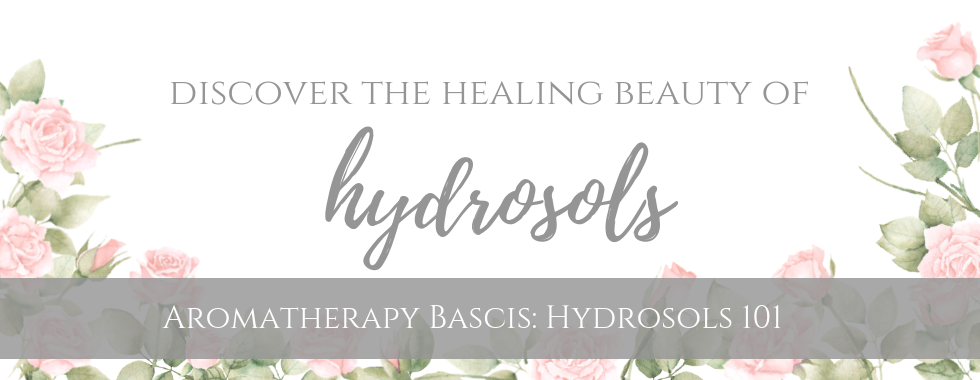
“Hydrosols are the condensate water co-produced during the steam- or hydro- distillation of plant material for therapeutic purposes.” - Suzanne Catty
Hydrosols have long been considered a powerful tool. As far back as the 11th century, plant material was distilled expressly for the hydrosols it produced; the essential oils were considered a by-product and often tossed aside. In Europe during the 18 th century, hydrosols were in high demand. This lead to new research on uses for the essential oil by-products. As more and more research was conducted, the incredible value of essential oils came to light. Today, essential oils are much more common therapeutically than hydrosols, but many feel that hydrosols are an invaluable tool not only in professional practice, but for applications in daily life.
Hydrosols are sometimes referred to as floral waters, distillates or hydrolats. Many products on the market are a combination of water, essential oil and an emulsifier. These may have additions of vegetable glycerin, PEG-40 hydrogenated castor oil, potassium sorbate, citric acid and dimethicone defoamer. Even in trace amounts, we consider these additions adulterations. These adulterations are not always displayed on the label; therefore we recommend that you seek out pure hydrosols from trusted suppliers for therapeutic uses.
HOW TO CARE FOR YOUR HYDROSOLS
It is important to store hydrosols properly as they are a delicate, fresh product. Do not store hydrosols in the refrigerator, instead keep them in a cool, dark, temperature stable place (10-13 degrees Celsius is ideal). Hydrosols are easily frozen with no detrimental effect, however, be sure to bring them to room temperature slowly.
Limiting your hydrosol’s exposure to oxygen significantly prolongs shelf life. When working with a large stock bottle, we recommend pouring a working amount into a smaller bottle to limit exposure to air from multiple openings. Pouring your hydrosol into smaller bottles to limit the headspace, the amount of empty space in your bottle, is also helpful.
Hydrosols must also be kept from contamination of bacteria. When pouring we recommend sterilizing your worktable, tools and containers (including lids, mister tubes, etc.) with 95% ethyl alcohol (ethanol) or food grade hydrogen peroxide first. This is another reason to have a smaller bottle with a working amount of hydrosol, to ensure you stock bottle is kept sterile.
If a hydrosol is contaminated with bacteria or as it naturally ages, it can grow a ‘bloom’. This is characterized by cloudy sediment that forms inside of the bottle. Once this happens the hydrosol should no longer be used therapeutically. Note that simply filtering the hydrosol will not completely remove the contamination from the hydrosol.
Also be aware that diluting hydrosols with water shortens their shelf life. If doing so, we recommend using distilled water to ensure it is free from contaminants.
Following these tips will give your hydrosols the longest possible shelf life, typically hydrosols last between one to two years.
HOW TO USE HYDROSOLS
Skin Care
- Tone the face after washing
- Mist the face for refreshing the skin
- Make a cream or lotion, use a hydrosol as the water phase of your recipe
- Tired, irritated eyes? Soak a small pad with hydrosol and compress your closed eyes for great relief
Wound Care
- Wash: soak a small cotton pad or gauze with hydrosol to pat over the wound to clean. If the cut or abrasion has a lot of dirt or debris try adding 1 ml of an unscented soap to 60 ml of hydrosol to wash the wound. Rinse thoroughly with water.
- Compress: after suffering a contusion, a hydrosol compress can be very relieving. Soak a cloth with your choice of hydrosol and press on the affected area. This approach can help relieve pain and prevent bruising.
- Soak/Irrigation: With cuts and abrasions, thorough cleaning is vital. Hydrosols provide a gentle immunological push to the healing process without disrupting the natural inflammatory phase. A hydrosol, in a bowl for soaking or a squeeze bottle for irrigating, is a great way to start that healing process.
Baby Care
Essential oils are not always safe to use on our youngest of loved ones. Hydrosols fill in the gap, providing a safe support for their health.
- Diaper rash: a compress after each diaper change will make all the difference!
- Bum wash: just as described for a wound wash, a hydrosol based wash can be very soothing during diaper changes. Even better, make your own baby bum wipes: fill a clean flat container half way with a hydrosol/ unscented soap mixture, as described above. Lay in folded flannels to soak up the hydrosol blend. Only make enough wipes to last 2 or 3 days, as hydrosols have no preservative in them.
Emotional Care
Whether you’re having a bad day at the office, or feeling under the weather, a hydrosol mist can really perk things up. Just mist the face or the air around your workstation and let the tension go.
Try using hydrosols instead of water the next time you...
- Fill your diffuser: with or without essential oils, hydrosols smell great in the diffuser.
- Use your Glass Nasal Inhaler: Feeling stuffy? Getting a cold? Pull out that Inhaler and fill the bottom with hydrosol instead of water, then add your essential oils and there you go! Hydrosols can be a great addition to a treatment protocol.
LEARN MORE
Two of our favourite books: Hydrosols The Next Aromatherapy by Suzanne Catty, and Understanding Hydrolats: The Specific Hydrosols for Aromatherapy by Len and Shirley Price.
If you’re new to the use of hydrosols, we hope that you’ll love experimenting with them and making them a part of your life. If you’ve used them before, we hope you’ve been inspired with some new ideas. Hydrosols are gentle yet powerful, subtle yet strong. They are a true wonder and gift from the plant kingdom.

